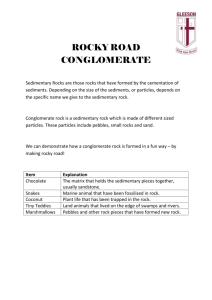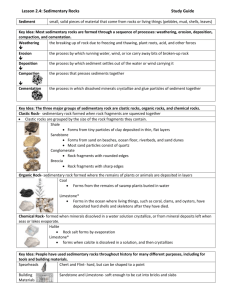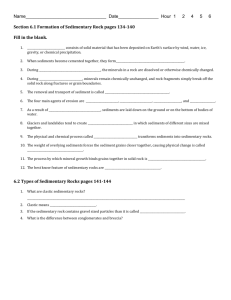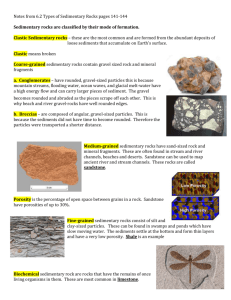Agenda (Lesson Sequence)
advertisement
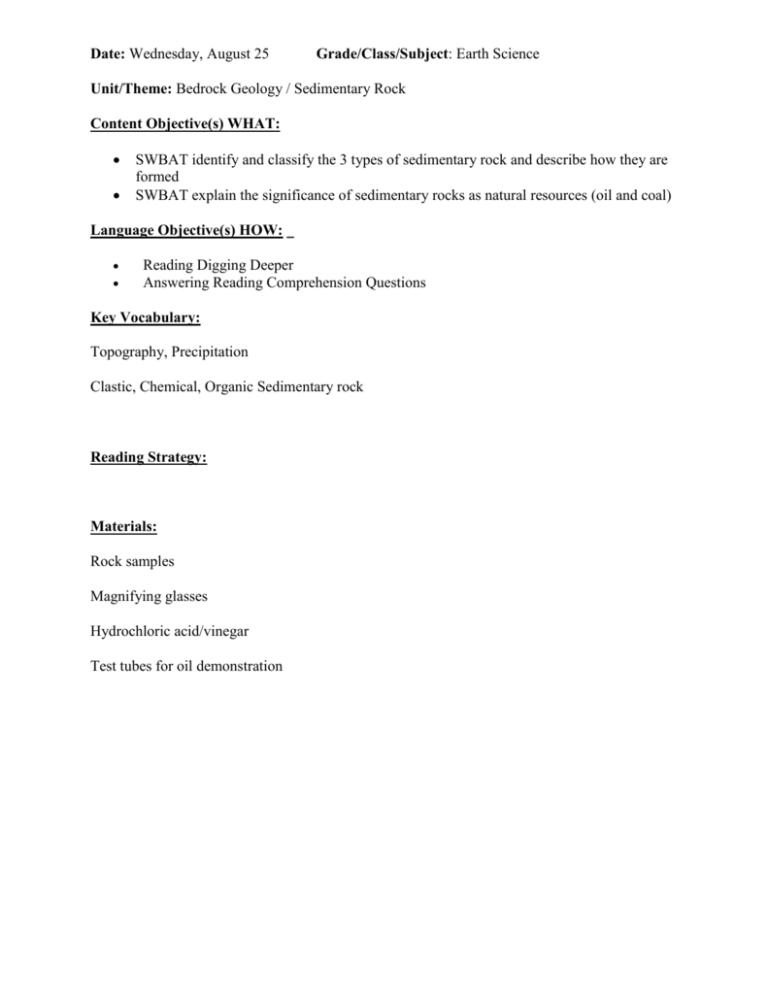
Date: Wednesday, August 25 Grade/Class/Subject: Earth Science Unit/Theme: Bedrock Geology / Sedimentary Rock Content Objective(s) WHAT: SWBAT identify and classify the 3 types of sedimentary rock and describe how they are formed SWBAT explain the significance of sedimentary rocks as natural resources (oil and coal) Language Objective(s) HOW: _ Reading Digging Deeper Answering Reading Comprehension Questions Key Vocabulary: Topography, Precipitation Clastic, Chemical, Organic Sedimentary rock Reading Strategy: Materials: Rock samples Magnifying glasses Hydrochloric acid/vinegar Test tubes for oil demonstration Agenda (Lesson Sequence): Action Phase 1: Engage Capture student attention, activate student prior knowledge, stimulate thinking, raise key questions, etc. 1 Time: 5 minutes Go over objective. Make Real World Connection. Do Now: How are sedimentary rocks formed? Phase 2: Explore Allow students to observe, record data, isolate variables, design and plan experiments, create graphs, interpret results, develop hypotheses, and organize their findings. Time: 15 minutes Activity 2: Split students into 3-4 groups. Each group sends someone up to collect materials. Students examine rocks and fill out data table on their activity sheet. I circulate and help where needed. (Beforehand, I must explain what HCl does) Phase 3: Explain Introduce laws, models, theories, and vocabulary. Guide students toward coherent generalizations, and help students understand and use scientific vocabulary to explain the results of their explorations Time: 25 minutes Phase descriptions adapted from Eisenkraft, Arthur. “Expanding the 5 E Model.” http://www.its-abouttime.com/htmls/ap/eisenkrafttst.pdf, accessed 1/4/08 1 Students read pp. U9 – U10 and U12 and answer reading comprehension questions on their activity sheet. I cold call students on questions and put up words on word wall. I give them a chance to revise their answers. Then, I reveal the identities of the rocks and which type they are. I present a PowerPoint with animations of Clastic formation, Coal formation, Oil formation and (need to find it) Chemical formation. Also will include a little bit about getting coal and oil out of the earth and why oil is found in sedimentary rock. Talk about how limestone is seashells and oil is dead micro-organisms that drifted to the bottom of the sea. To demonstrate why porous rock collects oil, I will take 2 test tubes (one clay, one sand) and pour water into them. They write a concluding sentence on what they learned about. Phase 4: Elaborate Phase 5: Evaluate Provide students opportunity to apply their knowledge to new domains, raise new questions, and explore new hypotheses. May also include related problems for students to solve. Administer formative assessment (although checking for understanding should be done throughout the lesson) Time: 0 Time: 10 Students fill out Exit-Slip 1. What are the two processes that convert sediments into sedimentary rock? 2. The top of Mt. Everest is made of limestone. What does this suggest about how the topography of that area has changed through time? 3. What kind of sedimentary rock is formed by direct precipitation of minerals from a solution? 4. Why do geologists usually look for sedimentary rocks when they are looking for oil? 5. Rock salt is mined throughout the Great Lakes region. What does this suggest about the past climate of this area? Questions: Knowledge 1. What are the three types of sedimentary rock? 2. Which type of rock is formed from fragments of older rocks? Comprehension 1. How are clastic S. rocks formed? 2. How are I. rocks formed? Application 1. What type of rock is ____________ (sample)? 2. Analysis 1. What is the difference between clastic and organic S. rocks? 2. Synthesis 1. 2. Evaluation 1. 2.





